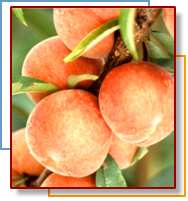Home | FOOD ARTICLES | Food Trivia | Today_in_Food_History | Food_History_Timeline | Recipes | Cooking_Tips | Food_Videos | Food_Quotes | Who’s_Who | Culinary_Schools_&_Tours | Food_Trivia_Quizzes | Food_Poems | Free_Magazines | Food_Festivals_and_Events
Food Articles, News & Features Section
FREE Magazines
and other Publications
Free Professional and Technical Research, White Papers, Case Studies, Magazines, and eBooks
PEACHES
See also: Peach Trivia; Peach Kitchen Tips; Peach Quotes; Nectarines
The peach is a member of the rose family. It was first cultivated in China and revered as a symbol of longevity. The image was placed on pottery and received as a gift with great esteem. Travelers along caravan routes carried the peach seed to Persia before it was cultivated in Europe. In the early 1600s Spanish explorers brought it to the New World and by the 1700s missionaries had established peaches in California.
Varieties
Peaches are available almost all year. The season dictates the variety. Semi-freestones (Queencrest) are early season late April to June. In mid-June the market shifts to freestone (Elegant Lady) or clingstone. On the off seasons peaches are imported into the U.S. from Chile and Mexico. Fresh varieties are sold as freestone while clingstone is usually used for canning. The fruit inside these peaches is either yellow or white. The white flesh is a "sub-acid" fruit its flavor is more sugary sweet. The more traditional color is yellow. It's more acidic, which does give it a bit more flavor. Half of the United States crop comes from the South and the other half from California. The United States also produces 25% of the total world market (THE PACKER 1999).
 Selecting
Selecting
When selecting fresh peaches, look for ones that are soft to the touch, blemish free, and have a fragrant smell. Peaches that are mildly fragrant ripen into sweet and delicious flavors. Choose fruit that has a background color of yellow or cream and has a fresh looking appearance. Peaches may have some red "blush" depending on the variety, but this isn’t a sign of how the fruit will taste after it’s ripened. At home peaches can be ripened at room temperature in a brown paper bag in 2 to 3 days. Peaches are highly perishable, so don't buy more than you plan to use. When selecting can peaches, choose those labeled "packed in it's own juice" and "no added sugar"; these are the healthier choices.
Storing
The best time to eat peaches is when they are ripe. If they need to be stored they should be stored out of the sun in a cool area or stored in the refrigerator for 3 to 5 days. Peaches that need to be ripened can be stored in the refrigerator for up to 2 weeks, then ripened in a bag as stated above. Ripe peaches taste best when they're eaten at room temperature. So remember to take them out of the refrigerator one hour before eating. That way you'll really enjoy their sweet and juicy flavor!
Use
Wash peaches carefully in cool soapy water, then rinse well before eating or using. If used in cooking they peel really fast if blanched in boiling water for a minute then plunged into ice water to cool. In fruit salads or platters, sprinkle cut peaches with lemon juice to help them keep their great color.
 Make Peaches Part of Your 5 A Day Plan
Make Peaches Part of Your 5 A Day Plan
Whether fresh, canned or frozen, peaches are nutritious: fat free, cholesterol free, sodium free, and high in vitamins A and C. One serving in your 5 a day plan is equal to one medium size fruit, 1/2 cup of cut up, canned, frozen or fresh fruit, or 6 oz of 100% peach juice. Peaches can be enjoyed in a variety of ways.
- Slice peaches and add to your favorite cereal, or as a topper to pancakes or waffles.
- Take a peach or a cup of canned peaches to work or school for a lite snack.
- Include peaches in low fat yogurt or cottage cheese and put on toast.
- Combine peaches and other fresh fruits into a fruit salad and use as a dessert or appetizer before dinner. Keep it tasty and brightly colored by adding a bit of concentrated orange juice.
- Make a peach smoothie with yogurt and peaches in a blender for breakfast or a snack.
- Bake, grill, or broil and serve along with your favorite meat or fish dinners.
- As a dessert cut it fresh and add to angel food cake or over lowfat frozen yogurt
- Freeze a can of peaches in the freezer then open and blend in the blender for a great summer dessert sorbet.
RELATED ARTICLES
Please feel free to link to any pages of FoodReference.com from your website.
For permission to use any of this content please E-mail: james@foodreference.com
All contents are copyright © 1990 - 2025 James T. Ehler and www.FoodReference.com unless otherwise noted. All rights reserved.
You may copy and use portions of this website for non-commercial, personal use only.
Any other use of these materials without prior written authorization is not very nice and violates the copyright.
Please take the time to request permission.

